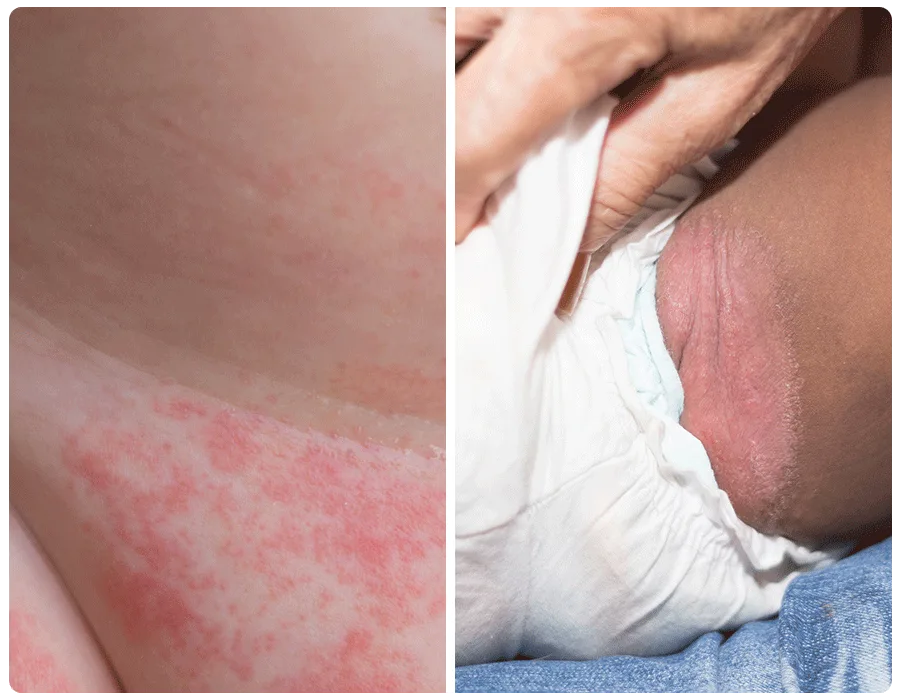How to Tell if Baby Has a Yeast Diaper Rash (and How to Heal It)
Chances are, you’ve changed a lot of diapers since baby arrived. But just when you think you’ve seen everything—impressive amounts of pee, all shades of poop and occasional pink rashes—you spot something that gives you pause and forces you to take a closer look: a yeast diaper rash. Don’t worry, it’s not as bad as it sounds—in fact, it’s quite common. Here, experts walk you through what causes this type of baby yeast infection, how to treat it and ways to prevent it from surfacing again in the future.
You might think of yeast diaper rash as a kind of extreme diaper rash. It’s usually caused when baby has an existing diaper rash or irritated skin that allows for candida overgrowth, explains Danelle Fisher, MD, a pediatrician at Providence Saint John’s Health Center in Santa Monica, California. Candida is a type of yeast and fungus that naturally lives on human skin, typically without incident. However, it loves warm, moist environments, so when given the right circumstances (such as a wet diaper and existing rash), the fungus can grow out of control and infect the skin. (For reference, when a baby yeast infection occurs in the diaper area, it’s a yeast diaper rash; when it happens in the mouth or throat, it’s called thrush.)
While unpleasant and uncomfortable, yeast diaper rash is incredibly common, adds Dendy Engelman, MD, FACMS, FAAD, a board-certified dermatologist in New York City and Mohs surgeon who specializes in medical and cosmetic dermatology.
The difference between regular diaper rash and an infant yeast infection is the underlying cause, Engelman explains. Your run-of-the-mill diaper rash is essentially a skin irritation, or what dermatologists call dermatitis. It occurs because baby’s skin is sensitive, and the wetness from urine and poop, plus friction from the diaper, can cause your little one’s skin to get inflamed and feel as if it’s burning. A yeast diaper rash, on the other hand, is caused by an infection with candida (more on this below). The skin barrier weakens with irritated skin (or diaper rash), allowing candida to penetrate and grow beneath it. While both rashes can be painful, a yeast rash can also be intensely itchy, says Fisher.
As noted, yeast diaper rash occurs when the existing candida on baby’s body overgrows due to a warm and wet environment, such as baby’s diaper. Per Cleveland Clinic, yeast diaper rash can occur if baby stays in a wet diaper for too long. This can cause irritation from the friction of baby’s diaper, as well as their urine and stool. It also restricts airflow to baby’s diaper area.
Yeast diaper rash may also be caused by a switch in baby’s diet, such as starting solid foods, as this can change baby’s stools and exacerbate an existing diaper rash.
If baby has an allergic reaction to a new diaper or diaper wipes, it can also allow for candida overgrowth, leading to a fungal diaper rash, Engelman says.
Lastly, if baby (or a breastfeeding mom) is or has recently been on antibiotics, there’s a good chance baby’s rash is a fungal diaper rash. “Antibiotics can disturb the natural and healthy bacteria and yeast in the body,” Engelman says. In other words, they decrease the growth of good bacteria and increase the growth of fungus such as candida.
A regular diaper rash involves a reddening of the skin, “but there are varying degrees,” Fisher says. With a regular diaper rash, you’ll see splotchy, pink or rosy areas of skin in baby’s diaper area, including the buttocks, genitals and upper thighs. The condition is limited to the skin surface and the surface remains smooth. But a yeast diaper rash looks much redder and angrier. It could also come with red bumps and spots, says Gina Posner, MD, a pediatrician at MemorialCare Orange Coast Medical Center in Fountain Valley, California. Fisher also adds that it could be a rash with unusual borders. “The edges might have tiny red dots, called satellite lesions,” she says. You might also see peeling at the edges. Fungal diaper rash tends to erupt in baby’s folds of skin, like in the upper legs, genitals and bum.
Yeast diaper rash pictures in newborns and babies
You may be well stocked with creams and ointments to fight a run-of-the-mill diaper rash, but the proper fungal diaper rash treatment calls for something more. Because you need to knock out the fungus growth, regular diaper rash creams won’t clear a yeast diaper rash, Engelman says. If baby’s rash looks especially intense and/or your typical diaper rash creams aren’t working, call your pediatrician. They’ll want you to bring baby in so they can assess the skin and confirm the condition. “The location and appearance of the rash are helpful in making a diagnosis,” Engelman says. “In some cases, doctors may choose to swab the affected area to confirm the presence of yeast.”
If the pediatrician finds that baby has yeast diaper rash, they’ll likely recommend an antifungal cream for infants, such as nystatin or clotrimazole, Posner says. Nystatin is available by prescription only, and clotrimazole is available both over-the-counter (brand name Lotrimin) and by prescription. Miconazole is another common treatment option available over the counter. “For severe cases, a prescription medication may be required to properly treat the affected area. Barrier creams can also be useful as a secondary treatment to protect the skin while it’s healing,” Engelman adds.
Wondering if a fungal diaper rash is contagious? While it could be spread through contaminated towels, cloth diapers and changing tables, Engelman says yeast diaper rashes aren’t typically considered contagious.
Yeast diaper rash can take up to two weeks to resolve, but it often resolves faster than that. Engelman says you’ll likely see improvements in baby’s yeast diaper rash within two to three days.
Until baby’s fungal diaper rash has completely healed, you’ll want to take a few precautions—and these are the same ones you’ll take to prevent yeast diaper rash from happening in the first place.
The best way to prevent (and treat) fungal diaper rash is by keeping baby’s skin healthy and dry. Here, some tips experts want you to keep in mind:
- Reduce skin contact with pee and poop. Ideally, change baby’s diaper as soon as it gets soiled to prevent moisture buildup and candida overgrowth, Engelman says. (This could be as frequently as every two hours.) Opt for diapers that have super-absorbent gelling material, which helps wick away moisture, and protect skin with a petrolatum product (such as Aquafor), which acts as a barrier between the skin and any urine or fecal matter.
- Let the skin breathe. You want to keep baby’s skin as dry as possible, Fisher says. Do this by letting baby go diaper-free during the day whenever you can. “Allowing creams to air dry on the skin can enhance their effectiveness,” Engelman adds. Plus, make sure diapers fit properly and aren’t attached too tightly to allow baby’s skin to breathe. Using breathable disposable diapers will also help.
- Treat regular diaper rash as soon as possible. “If redness occurs, treat it early with a diaper cream with zinc oxide in it,” Fisher says.
- Go fragrance-free. When picking diapers, wipes and cleansers for baby, opt for ones that are gentle and fragrance-free to help reduce the risk of skin irritation, Engelman says.
Frequently Asked Questions
Do cloth vs. disposable diapers make a difference for yeast diaper rashes?
According to Engelman, for active fungal diaper rashes, using disposable diapers may be better to “avoid reusing potentially contaminated cloth diapers.” She adds that while cloth diapers can offer better airflow for baby, it’s best to bleach them after each use with a baby-safe detergent. Apart from these two factors, however, she says it’s really up to personal preference and baby’s needs when it comes to using cloth vs. disposable diapers.
Will aquaphor make a baby yeast infection worse?
“Aquaphor alone will not treat a baby’s yeast infection. Antifungal medication must be used,” Engelman says. However, it won’t make baby’s infection worse. In fact, caregivers can apply it over the antifungal medication to act as a protective barrier.
What antifungal cream is best for infant yeast infection?
While the best medication to use will depend on each situation, Engelman usually recommends using nystatin or clotrimazole for candidal diaper rash.
Can there be any complications for treating a yeast diaper rash?
While it isn’t common, Engelman notes there is a slight chance baby could also get a bacterial infection if their yeast diaper rash has open wounds. For this reason, it’s best to call your provider as soon as you notice the rash and start baby’s treatment immediately.
Babies go through hundreds of diapers until they’re potty trained, and because diapers provide the ideal environment for candida fungus to grow, it’s likely baby will experience a yeast diaper rash at least once or twice. Now that you know some of the signs to look out for, don’t hesitate to call your pediatrician if you ever spot any unusual rashes or patches of skin on baby. Rest assured that with the proper treatment, baby’s fungal diaper rash will clear up in no time.
Please note: The Bump and the materials and information it contains are not intended to, and do not constitute, medical or other health advice or diagnosis and should not be used as such. You should always consult with a qualified physician or health professional about your specific circumstances.
Plus, more from The Bump:
Dendy Engelman, MD, FACMS, FAAD, is a board-certified dermatologist in New York City and Mohs surgeon who specializes in medical and cosmetic dermatology. She earned her medical degree and completed her residency at the Medical University of South Carolina.
Danelle Fisher, MD, FAAP, is a pediatrician at Providence St. John’s Health Center in California. She earned her medical degree from Albert Einstein College of Medicine of Yeshiva University in New York City and completed her residency training at Children's Hospital Los Angeles in California.
Gina Posner, MD, is a pediatrician at MemorialCare Orange Coast Medical Center in Fountain Valley, California. She earned her medical degree from New York Medical College and completed her residency at White Memorial Medical Center in Los Angeles, California.
Cleveland Clinic, Yeast Diaper Rash, January 2022
Learn how we ensure the accuracy of our content through our editorial and medical review process.
Navigate forward to interact with the calendar and select a date. Press the question mark key to get the keyboard shortcuts for changing dates.






















































